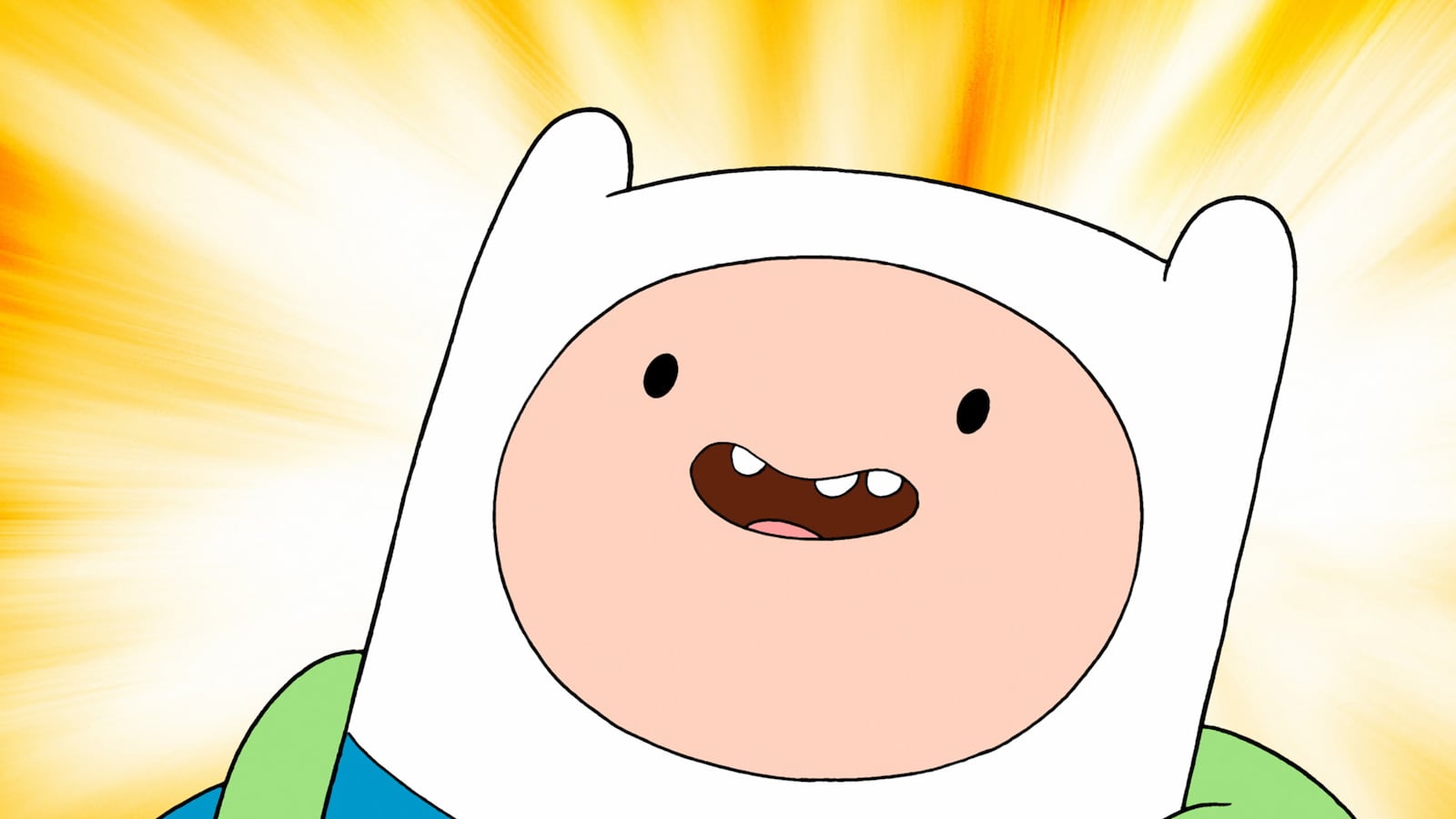As Homer Simpson once famously said about America’s beloved animated deities chosen to be in the Macy’s Thanksgiving Day Parade, “If you start building a balloon for every flash in the pan cartoon character, you'll turn the parade into a farce.”

But on this year on Thanksgiving morning, Finn the Human and Jake the Dog of Cartoon Network’s Adventure Time floated down 6th Avenue in oversized, inflatable versions of their animated selves and joined the ranks of this nation’s cartoon gods: Bart J. Simpson, Bullwinkle J. Moose, and Mickey Mouse.
Created by Pendleton Ward as an Internet short in 2006, the show was initially pitched to Nickelodeon, who passed, before debuting on Cartoon Network in April 2010. Adventure Time takes places in the Land of Ooo, a post-apocalyptic wasteland filled with magical creatures where series heroes Finn (Jeremy Shada, or young Charlie on Lost) and Jake (John DiMaggio of Futurama) battle against a pastiche of geekish villainy borrowed liberally from over four generations of video games and Monster Manuals.
The mythology of Adventure Time strongly implies events take place 1,000 years in the future where the world has been devastated by a catastrophic nuclear war that killed most humans. In an interview with Noelene Clark of the LA Times Hero Complex blog, Ward has said “It’s Candyland on the surface and dark underneath… my favorite kind of emotions—the ones that conflict with each other, and they feel weird inside of you.”
The show is aimed at children and pre-teens, but like SpongeBob SquarePants, Ren and Stimpy, and Rocco’s Modern Life, it has attracted a sizeable older fan base especially among parents, teens, and nerds of advanced ages.
Other series regulars include Tom Kenny (the voice of SpongeBob), Hynden Walch (Starfire from Teen Titans), and Steve Little (Eastbound and Down). Guest stars this season have included actors (Chloris Leachman, Lavar Burton, Maria Bamford), comedy greats (Donald Glover, Kristen Schaal, Marc Maron), and legendary voice over artists (Maurice LaMarche, Keith David, Ron Pearlman).Upcoming guest stars include creator of the hit HBO series Girls, Lena Dunham.
Since its first episode in 2010, with the exception of June 2011 and March 2012, there has been at least one episode of Adventure Time on Cartoon Network every month.
And that’s just on television.
November 2013 saw the release of a second video game Adventure Time: Explore the Dungeon Because I Don't Know! for Nintendo 3DS, PS3, Wii U, and XBOX 360. Adventure Time comics recently published their 25th issue. Adventure Time merchandise from bathrobes to lunchboxes are available from Hot Topic, We Love Fine, and Threadless. Halloween nights and comic conventions of the last few years have seen an increase in the number of children (and adults) all over the U.S. who wore Finn and Jake costumes. Internet series PBS Idea Channel has delved into the philosophy of the magical land where the series takes place. Most importantly, there is a community of Internet fan fiction dedicated to expanding the show’s already massive multiverse.
Every indication seems to be that Adventure Time is a hit. Farce or no farce.The show’s fifth season was barely two months old when, in January of 2013, rumors started to swirl about a sixth. That is, if the fifth season is ever finished. According to series producer Kent Osborne, “The fifth season started and at the beginning we all thought it was going to be like the previous seasons, 26 11-minute [episodes]. Then a few weeks into the season [Cartoon Network] let us know that we were extending the fifth season to make it twice as long. Had the fifth season ended when it was supposed to, we didn’t have a big episode to end on. Now we do.” And while he couldn’t elaborate much on the finale, it is “an episode that will excite many fans.”
Almost one year later, Adventure Time is still airing new episodes in the season, bringing the total number of ten-minute cartoons up to 43 broadcast so far, with an estimated 9 more to go. Despite each episode’s short run time, that would work out to approximately 27 half-hour installments on one of the big networks. To put that into perspective, the longest season of The Simpsons (the ninth) clocks in at 9 hours and thirty minutes. Adventure Time’s current season is already at 8 hours and 14 minutes, with about an hour and a half left to air.
***
Each episode of Adventure Time takes about nine months to produce and begins in a writer’s room with series creator Ward, producers Adam Muto and Kent Osborne, and staff writer Jack Pendarvis. From that meeting, they generate a barebones, two-page outline. Those outlines are handed over to one of four storyboard teams who have two weeks to visually outline the episode. “They’re basically directing,” says Osborne. “They’re writing all the jokes, editing the outline, picking all the camera shots… what the episode is going to look like.”
The storyboard teams then pitch their outlines to Osborne and each other where they get notes and another two weeks to address those notes. “That is about five weeks.” Osborne said. “Then there’s a couple weeks where the board is sent to the Network for notes and it’s being prepared for a voice record.”
When the network notes and voices are ready, the storyboards are assembled into an animatic where the cleaned up drawings, poses, and shots appear along with dialogue which takes a few more weeks to build. “There’s layout design and background design and color design going on,” says Osborne. “This is all to prepare for sending it overseas to Korea.”
Adventure Time then contracts their animation out to Rough Draft Studios in Seoul. Founded by Greg Vanzo and his wife Nikki during their work on Ren and Stimpy, Rough Draft Studios has animated some of the most well known properties in cartoonery, including The Simpsons, Beavis & Butthead, The Poweruff Girls, and Futurama.
About three months later, the fully animated product is sent back to America where final changes are reviewed and implemented. “There’s a round of retakes, where we look for mistakes that might have been made or things that didn’t animate the way we intended.” Osborne says. “Then there’s a few weeks of sound design where we add effects or record additional dialogue.
The emotional depth of episodes has also increased this season.
One of the most poignant episodes this season was March 25th’s “Simon and Marcy” directed by Adam Muto and written by Cole Sanchez and Rebecca Sugar. The episode takes place many years before the main events of the series. In it, a young Marcelline (Ava Acres) has come down with a cold and is in need of medicine. Her protector is revealed as series villain, The Ice King. Unable to protect young Marcelline from the post-apocalyptic world’s many dangers, Simon uses a crown that grants the wearer tremendous magical power, but causes him to forget who he is. Aware of its dangers, the episode begins with Simon promising Marcelline that he won’t wear it again, but ends with him forced to put it on once more to save her even as it means losing himself.
Osborne says the show’s thematic direction was never a conscious decision. “The Simon and Marcy episode came about because there’s an earlier episode where The Ice King has a wig on and is singing Marcelline’s fry song. Someone pointed out that those two characters had never shared screentime and we were trying to use that as a springboard to think of why we haven’t seen them together. All that was natural and organic. It came out of the process.”
It is in comparison to America’s longest running animated program that Adventure Time shines the brightest. Where The Simpsons are frequently criticized for losing the emotional relevance that permeated their early seasons, Adventure Time embraces its cartoonishness and loses little by way of story heart. On The Simpsons, the characters don’t age. Even on SpongeBob where Osborne was once a writer, “I haven’t watched it in a while, but he’s living in a pineapple. He’s got the same job. On Adventure Time there’s characters who date and break up. We’re constantly learning more about their histories. I think that helps a lot.”
***
At FanExpo 2013, Pendleton Ward exhibited five of his favorite episodes including one from the fifth season dedicated to recently deceased storyboard artist Armen Mirzaian. Finn and Jake have temporarily lost their ability to speak during a game and are attacked by a squad of bikini babes hired to solve the mystery by friend, and sentient video game console, BMO (voiced by former storyboard artist Niki Yang). To the uninitiated, it can seem all too random, slapdash, or disorienting.
“Penn likes to use the example of Dungeons and Dragons. He made the pilot and then he was just playing the game with the audience. Seeing where it goes. One of the reasons the storyboard teams pitch to the writing staff is so that we can expand on what they’ve come up with and go from there. There was no plan there from the beginning.”
Still, there are some long term plans, sometimes even hidden in the show. When asked about some of his favorites from this season Osborne mentions “The Vault.” “It was [story]boarded by Jesse Moynihan and Ako Castuera. Jesse actually came up with the story and it has to do with something he planted in the show a couple of seasons ago. There’s an episode where they’re in a haunted house and it’s all a prank, but Finn sees this vision of a green lady. Two seasons later he comes up with this episode.” In “The Vault,” Finn suffers from mysterious sleepwalking night terrors that turn out to be induced by a long suffering ghost whose bones are hidden in the walls of his home. The episode tells the Green Lady’s story via flashbacks, including her tragic death. “It kills me, [she is] in Purgatory for 500 years. It just kills me.”
“The mistake a lot of people make,” says Osborne “is they don’t trust that kids are really smart and watch a lot of television and a lot of movies. You don’t have to spell things out for them. You don’t have to over explain it. They get it right away.”






